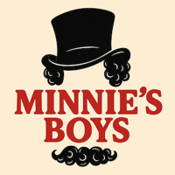
Overview
Synopsis
Minnie’s Boys tells the story of how a determined mother, Minnie Marx, guided her five sons—Groucho, Harpo, Chico, Zeppo, and Gummo—from their modest beginnings in New York’s vaudeville circuit to becoming one of the most celebrated comedy acts in American entertainment history. Set against the backdrop of early 20th-century show business, the musical opens with the family struggling to make ends meet as their father’s tailoring business fails. Minnie, recognizing her sons’ sharp wit and natural stage presence, takes charge of their careers, shaping them into a cohesive act and managing their every move. Her unwavering belief in their talent propels the Marx Brothers from small-time performances to national stardom.
As the brothers’ fame grows, the musical explores the complex emotional bond between Minnie and her sons, particularly her favorite, Groucho. While her fierce devotion helps them achieve success, it also creates tension as the boys begin to assert their independence. By the show’s end, Minnie must face the bittersweet reality that the children she pushed toward fame have outgrown her control. Combining humor, vaudeville routines, and heartfelt family moments, Minnie’s Boys celebrates the Marx Brothers’ legacy while offering a poignant look at the sacrifices behind their comedic brilliance.
Show Information
Context
When Minnie’s Boys premiered on Broadway in 1970, it arrived at a time when audiences were rediscovering the appeal of early 20th-century comedy and nostalgic Americana. The musical was a biographical tribute to the Marx Brothers, one of the most iconic comedy teams in history, and especially to the family matriarch, Minnie Marx, whose ambition and perseverance helped transform her sons from scrappy vaudeville performers into international stars. The book, written by Arthur Marx (Groucho’s
to read the context for Minnie's Boys and to unlock other amazing theatre resources!Plot
Characters
| Name | Part Size | Gender | Vocal Part |
|---|---|---|---|
|
Lead |
Male |
Baritone |
|
|
Lead |
Female |
Mezzo-Soprano |
|
|
Supporting |
Male |
Tenor |
|
|
Supporting |
Male |
Non-singer |
|
|
Supporting |
Male |
Tenor, Baritone |
|
|
Featured |
Male |
Baritone |
|
|
Featured |
Male |
Baritone |
|
|
Featured |
Male |
Baritone |
|
|
Featured |
Male |
Baritone |
|
|
Featured |
Male |
Non-singer |
|
|
Featured |
Female |
Mezzo-Soprano, Non-singer |
|
|
Ensemble |
Not Specified |
|
Songs
Act I
Act II
A song with an asterisk (*) before the title indicates a dance number.
Monologues
Scenes
Key Terms
A genre of drama based on real people’s lives, exploring their challenges, accomplishments, and inner conflicts.
A musical with a well-structured narrative that integrates songs, dialogue, and dance to advance plot and character development.
A character arc is the journey of personal growth, change, or transformation that a character undergoes throughout a play or musical. It often involves overcoming internal or external obstacles, leading to a deeper understanding of oneself or others. Strong arcs help audiences connect emotionally with characters and give structure to the overall narrative.
The imaginary wall separating the audience from the actors onstage, often 'broken' for direct address. This term plays a vital role in understanding theatrical structure and is commonly encountered in stagecraft or performance settings.
A form of theatre with a series of short sketches, songs, and dances, often satirical and lacking a unified narrative.
Slapstick is a type of physical comedy that relies on exaggerated actions, pratfalls, and humorous accidents to provoke laughter. It often includes broad movements, funny sound effects, and comic violence, such as someone slipping on a banana peel or being hit with a harmless object. The style originated in commedia dell’arte and became popular in vaudeville, silent film, and stage comedy.
A variety entertainment form popular in the U.S. from the late 19th century to the early 20th, featuring diverse short acts.
Videos
Quizzes
Themes, Symbols & Motifs
Themes
Family and Sacrifice
At its heart,
to read about the themes, symbols and motifs from Minnie's Boys and to unlock other amazing theatre resources!Quote Analysis
Sorry! We do not currently have learning modules for this guide.
